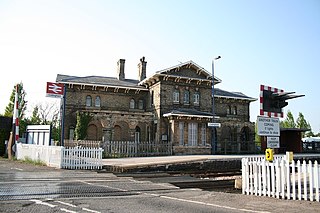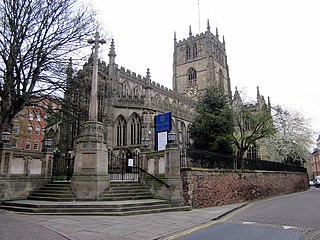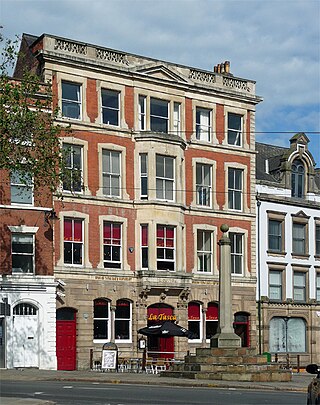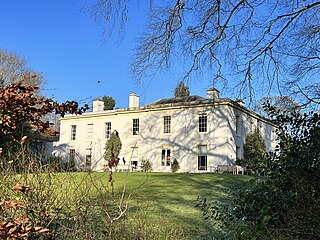
Beeston is a town in the Borough of Broxtowe, Nottinghamshire, England, it is 3 miles south-west of Nottingham. To its north-east is the University of Nottingham's main campus, University Park. The headquarters of pharmaceutical and retail chemist group Boots are 0.6 miles (1 km) east of the centre of Beeston, on the border with Broxtowe and the City of Nottingham. To the south lie the River Trent and the village of Attenborough, with extensive wetlands.

Nottingham Trent University (NTU) is a public research university located in Nottingham, England. Its origins date back to 1843 with the establishment of the Nottingham Government School of Design, which still operates within the university.

Collingham railway station is in the village of Collingham, Nottinghamshire, England, on the Nottingham to Lincoln Line. It is owned by Network Rail and managed by East Midlands Railway, which provide all services.

Nottingham was a parliamentary borough in Nottinghamshire, which elected two Members of Parliament (MPs) to the House of Commons from 1295. In 1885 the constituency was abolished and the city of Nottingham divided into three single-member constituencies.
The University of Nottingham operates from four campuses in Nottinghamshire and from two overseas campuses, one in Ningbo, China and the other in Semenyih, Malaysia. The Ningbo campus was officially opened on 23 February 2005 by the then British Deputy Prime Minister, John Prescott, in the presence of Chinese education minister Zhou Ji and State Counsellor Chen Zhili. The Malaysia campus was the first purpose-built UK university campus in a foreign country and was officially opened by Najib Tun Razak on 26 September 2005. Najib Tun Razak, as well as being a Nottingham alumnus, was Deputy Prime Minister of Malaysia at the time and has since become Prime Minister of Malaysia.

Edward Joseph Lowe FRS FGS FRAS FLS was a British botanist, meteorologist and astronomer, who published papers on a wide variety of subjects, including luminous meteors, sunspots, the zodiacal light, meteorological observations during the 1860 solar eclipse, conchology, ferns, grasses and other plants.

Thomas Chambers Hine was an architect based in Nottingham.
Founded in 1843, the School of Art & Design at Nottingham Trent University is one of the oldest in the United Kingdom.

The Church of St Mary the Virgin is the oldest parish church of Nottingham, in Nottinghamshire, England. The church is Grade I listed by the Department for Digital, Culture, Media and Sport as a building of outstanding architectural or historic interest. It is one of only five Grade I listed buildings in the City of Nottingham.

Captain Gilbert Smith Doughty CE was an architect based in Nottingham and Matlock.

William Arthur Heazell FRIBA was an architect based in Nottingham.

Robert Clarke was an architect based in Nottingham.

Robert Charles Clarke was an architect based in Nottingham.

John Collyer was an architect based in Nottingham.

Francis Williamson was a British surveyor and architect based in Nottingham.

Charles Leighfield Jonah Doman FRBS was a sculptor from Nottingham.
George Eaton Stanger MRCSE LSA (1816-1892) was an English surgeon based in Nottingham.

Ulmus × hollandica 'Nottingham' is an elm cultivar. It was distributed from the early nineteenth century as 'Siberian elm' by Castle Nurseries, Nottingham, and much planted locally. Richens (1983) described it as a hybrid, possibly of French origin, between wych elm Ulmus glabra and field elm Ulmus minor. He called it Nottingham elm.

Alfred Joseph Lowe J.P. was a horticulturalist, meteorologist and astronomer based in Nottingham.

Broadgate House is a Grade II listed building in Beeston, Nottingham.



















